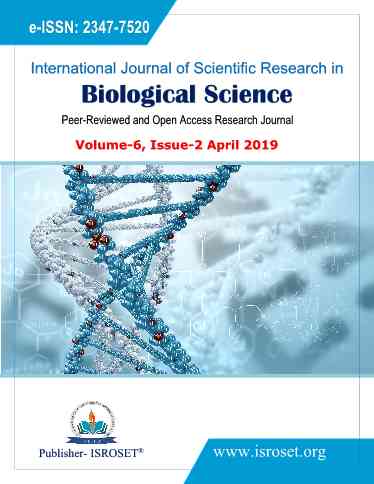Production Kinetics of Xylanase and Carboxy-methyl Cellulase of Schizophyllum commune in Submerged Fermentation Technique
Keywords:
Tamarind kernel powder, Schizophyllum commune, xylanase, CMCaseAbstract
Tamarind kernel powder (TKP), a soluble agro-residue was used to evaluate the production of xylanase and CMCase in submerged culture of Schizophyllum commune, a white rot basidiomycetes fungi. Soluble TKP containing xyloglucan as the major polysaccharide induced significantly xylanase production but CMCase production was not significantly improved. The culture filtrate consisting of xylanase and CMCase at a ratio of 10:1 (approx) and 1.5:1(approx) in TKP and cellulose medium respectively. It may therefore, be indicative that inducer molecules released from TKP or cellulose were not identical and Tamarind kernel powder, although structurally similar to cellulose, therefore, was found to be the perfect inducer for xylanase production in submerged culture of Schizophyllum commune. Use of mixed substrate in a single set of fermentation reveals that addition of 0.5 % TKP in cellulose medium improved CMCase titer, whereas addition of 0.5 % cellulose in TKP medium did not increased the production level of xylanase. Therefore, the present study reports the successful economic utilization of TKP, an abundantly available for the production of xylanase, an enzyme of industrial importance.
References
C. Botella, A. Diaz, I. D. Ory, C. Webb, A. Blandino. “Xylanase and Pectinase Producion by Aspergillus awamori on grape pomace in Solid State Fermentation”. Proces. Biochem., Vol. 42, pp. 98-101, 2007.
E. Metreveli, E. Kachlishvili, S. W. Singer, V. Elisashvili. “Alteration of White-rot Basidiomycetes Cellulase and Xylanase Activities in the Submerged Co-cultivation and Optimization of Enzyme Production by Irpex lacteus and Schizophyllum commune”, Biores. Technol., Vol. 241, pp. 652-660, 2017.
A. Gautam, A. Kumar, A. K. Bharti, D. Dutt. “Rice Straw Fermentation by Schizophyllum commune ARC-11 to Produce High Level of Xylanase for its Application in Pre-bleaching”, J. Gen. Eng. Biotechnol. Vol. 18, No. 2, pp. 693-701, 2018.
S. Sengupta, M. L. Jana, D. Sengupta, D. Sengupta, A. K. Naskar. “A Note on the Estimation of Microbial Glycosidase Activities by Dinitrosalicyclic Acid Reagent. Appl. Microbiol. Biotechnol. Vol. 53, pp. 732-735
D. Haltrich, B. Sebesta, W. Steiner. “Induction of Xylanase and Cellulase in Schizophyllum commune”. In Enzymatic Degradation of Insoluble Carbohydrates. ACS Symposium, Series 618, American Chemical Society, Washinton DC, USA , pp. 305-318, 1995
J. A. Brown, S. A. Colin, T. M. Wood. “Development of a Medium for High Cellulase, Xylanase and β-glucosidase Production by a Mutant Strain (NTG III/6) of the Cellulolytic Fungus Penicillum pinophyllum”. Enz. Microbiol. Technol. Vol. 9, pp 355-360.
R. Chatterjee, K. Majumder, S. Sengupta. “Tamarind Kernel Powder Co-induces Xylanase and Cellulase Production During Submerged Fermentation of Termitomyces clypeatus”, Biotechnol. Bioproc. Eng., Vol. 15, pp. 854-861, 2010.
D. Haltrich, W. Steiner, “Formation of Xylanase by Schizophyllum commune: Effect of Medium Components”, Enz. Microbial Technol., Vol. 16, No. 3, pp. 229-235, 1994.
M. J. Gidley, P. S. Lillford, D. W. Rowlands, P. Lang, M. Dentini, V. Crescenzi, S. M. Edward, C. Fanutti, J. S. G. Reid. “Structure and Solution Properties of Tamarind seed Polysaccharides”. Carbohydr. Res., Vol. 214, pp. 299-314, 1991.
K. Majumder, R. Chatterjee, S. Sengupta, “Production of Xylanase and CMCase in Polyurethane Foam based Solid-state Fermentation of Termitomyces clypeatus”, Int. J. Biotech. Bichem., Vol. 11, No. 1, pp. 63-78, 2015.
K. Kolenova, M. Vrsanska, P. Biely. “Purification and Characterization of Two Minor endo-β-1,4-xylanases of Schizophyllum commune”, Enz. Microb. Technol., Vol. 36, No. 7, pp. 903-910, 2005.
A. G. Pardo, M. Obertello, F. forchiassin. “Cellulose and Xylan Degrading Enzymes in Thecotheus pellelier:, Rev. Argent. Microbiol., Vol. 32, pp. 190-195, 2000.
Downloads
Published
How to Cite
Issue
Section
License

This work is licensed under a Creative Commons Attribution 4.0 International License.
Authors contributing to this journal agree to publish their articles under the Creative Commons Attribution 4.0 International License, allowing third parties to share their work (copy, distribute, transmit) and to adapt it, under the condition that the authors are given credit and that in the event of reuse or distribution, the terms of this license are made clear.







